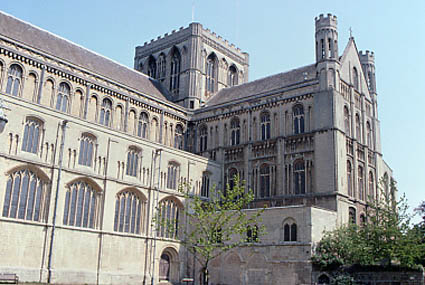| |
 |
Peterborough Peterborough Cathedral |
An abbey at Peterborough was founded by Peada, King of Mercia in 655. After destruction by the Vikings it was re-founded as a Benedictine house in c. 960. Reconstruction of the Anglo-Saxon church began in 1118 under Abbot John de Séez using the famous Barnack limestone of the region, and the eastern arm was complete by c. 1140. There was an aisled chancel of four bays with three apses at the east. The central apse largely survives encased in the later medieval east end. Early examples of horizontal, as opposed to the more common vertical, zig-zag decoration appears on the frieze below the gallery.
The transepts were built 1145 - 55. Parts of the original ceilings survive. The Norman tower was built c. 1160 - 70 and was higher than the present tower, which is late 19th century.
Work on the nave began c. 1160 and the basic design of the chancel was continued, although there is variation in the details. For example, while the capitals on the south side remain plain, those on the north side, being later, are decorated. Originally, the nave was intended to have nine bays with western towers, but in c. 1180 - 90 a tenth bay was added along with the western transepts. The style of the west end is 'transitional', in that, for example, the arches across the transept are pointed, but have the latest Norman detailing. The west façade with its three great niches was completed in c. 1230. The abbey church became a cathedral in 1541.
Norman structures in the former abbey precinct include the chapel in the bishop's palace and part of the main gateway.
Bibliography
Pevsner, N., 1968. The Buildings of England, Bedfordshire, County of Huntingdon and Peterborough (London, Penguin), 305-25
Reilly, L., 1997. An Architectural History of Peterborough Cathedral (Oxford)